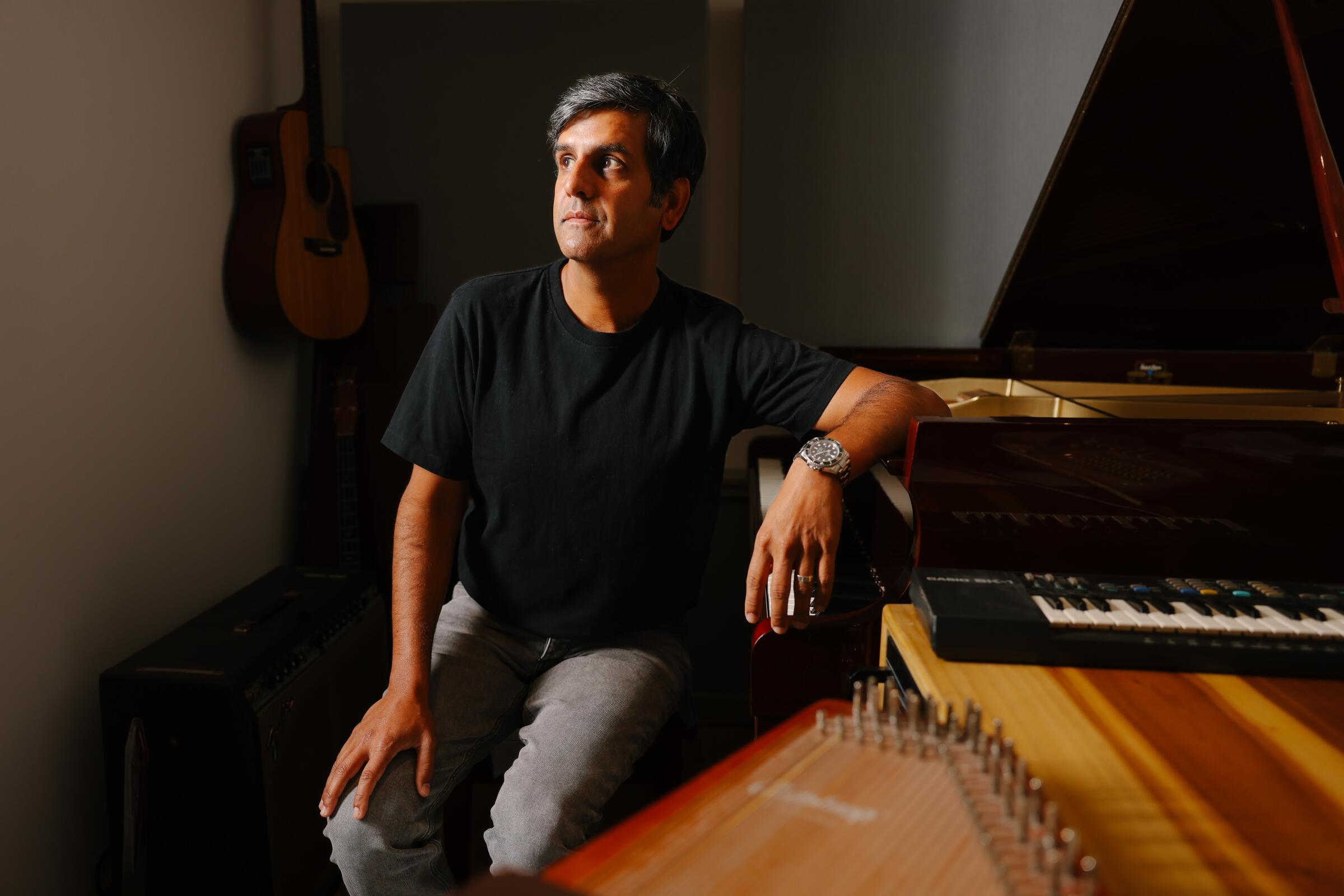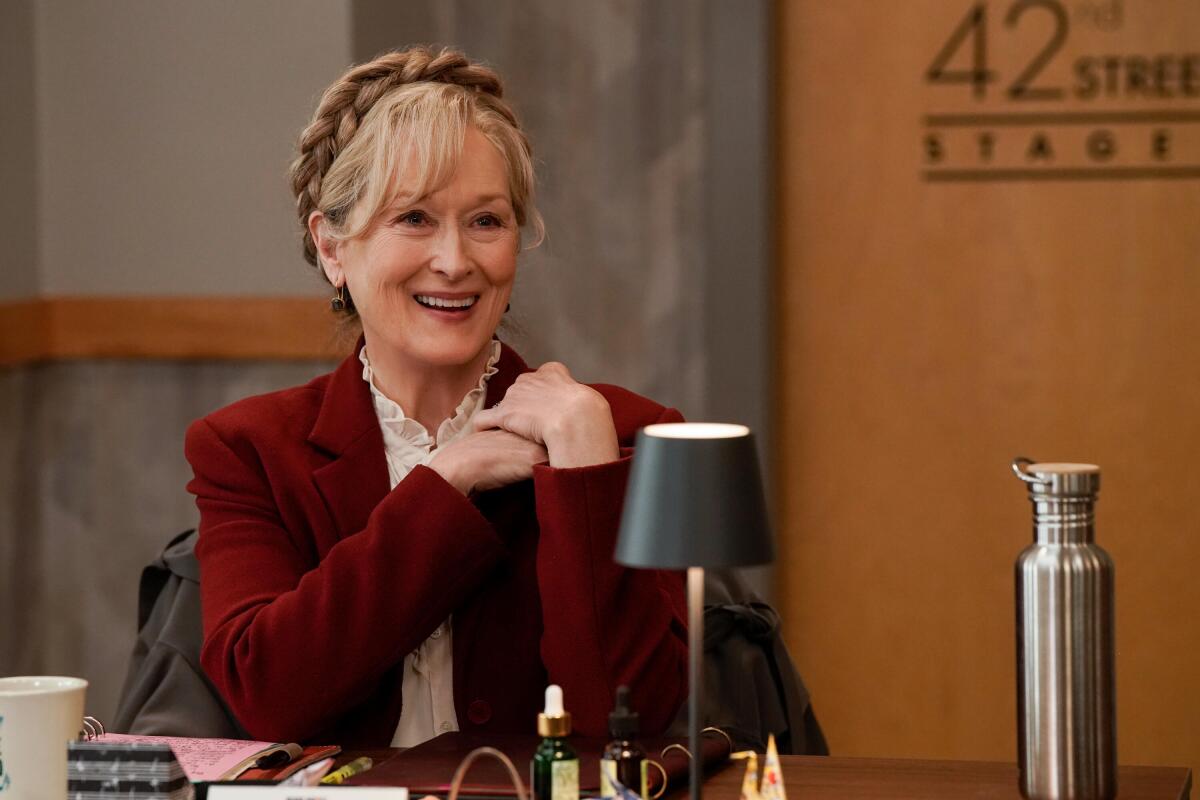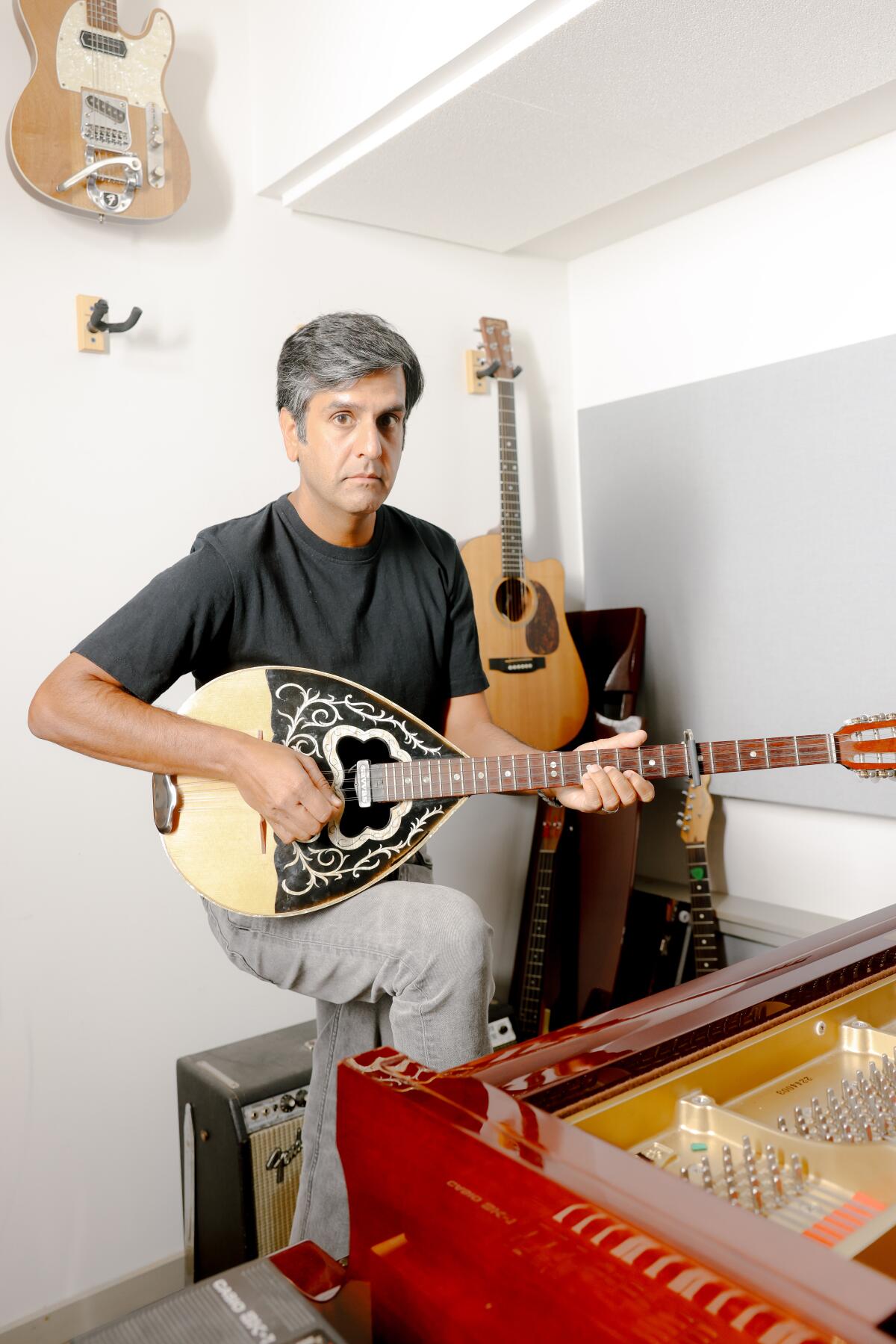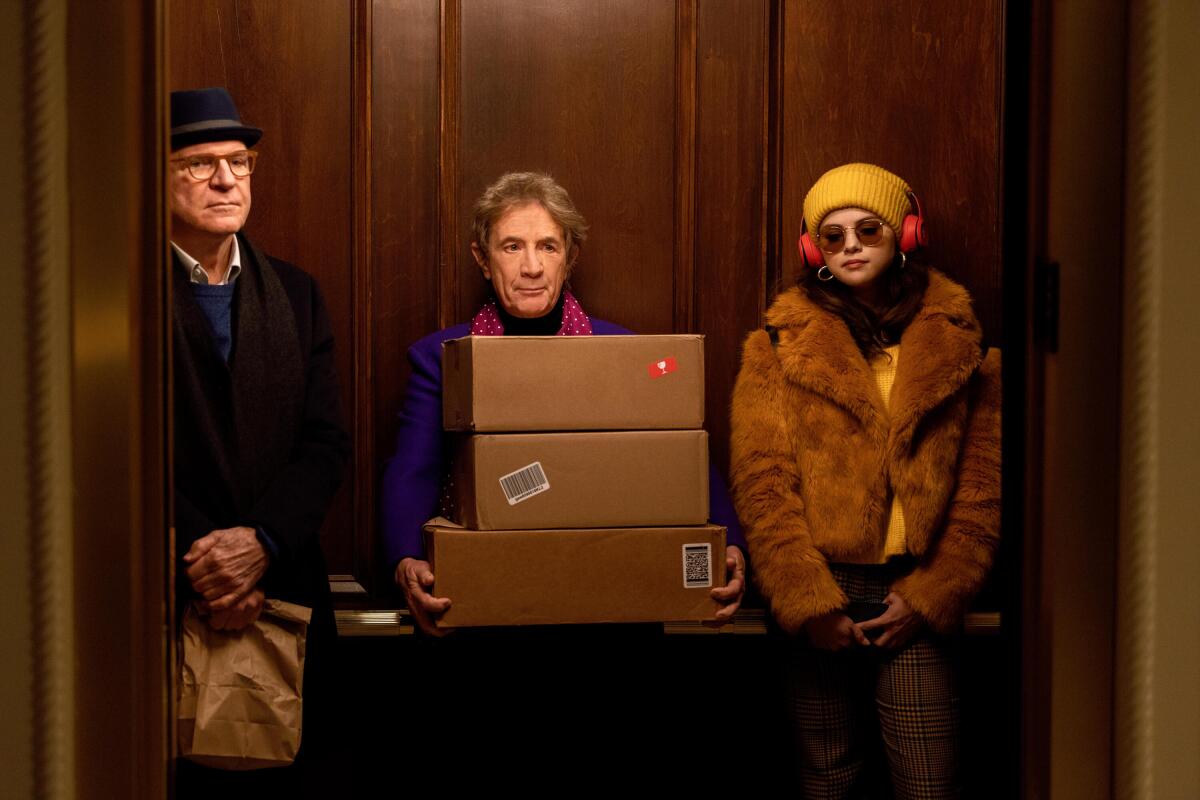The complete guide to home viewing
Get Screen Gab for everything about the TV shows and streaming movies everyone’s talking about.
You may occasionally receive promotional content from the Los Angeles Times.

This is the story about how a Hindi lullaby traveled from Connecticut to Delhi, and somehow found its way into the score for “Only Murders in the Building” four decades later. It sounds like a non sequitur — but when Siddhartha Khosla traces the arc of his life, there’s a consistent through line that makes as much sense as any good melody.
Khosla is the Emmy-nominated composer for the Hulu comedy-mystery series, which returned for its third season on Tuesday. The new episodes, released weekly, add Paul Rudd and Meryl Streep to the cast, which is led by Steve Martin, Martin Short and Selena Gomez as a trio of unlikely friends who keep solving — and getting implicated in — murders on the Upper West Side of Manhattan.
The score was recorded at the Fox scoring stage, a building with as rich a history as the show’s fictional Arconia apartment building. The music for “Only Murders” is equally refined, written for a chamber orchestra, and Khosla has added a new melody for French horn that is tied to Streep’s character. The instrument “just felt like Meryl,” he says. “It’s distinguished, classy, subtle — but also big when it needs to be big. It’s like the perfect actor.”

Everything comes back to melody for Khosla, whose parents immigrated from India to America in 1976 on scholarships to Yale’s graduate program. They came with only $8 and when “Sid” was born, like many other Indian immigrant families, they decided to send their infant son back to Delhi to live with his grandparents, aunts, uncles and cousins, who all lived in the same house.
Because long-distance phone calls were prohibitively expensive, Khosla’s mother would sing old Hindi lullabies and songs from ’60s Indian movies onto a cassette tape and mail it to her son across the world. He would babble something onto the same tape, which his grandparents would mail back to New Haven, Conn. — a cycle that repeated for several years.
“So my first experience in recorded music was my mom singing on this tape and me hearing it,” says Khosla. “All old Hindi melodies. The stuff that influences me the most in everything I do is Hindi music from the ’60s and ’70s.”
His parents kept singing to him after they brought him back to the States when he was four — they eventually settled in New Jersey — and his mother quickly noticed that he could sing. She wrote out the lyrics for classic Indian film songs by composers like S. D. Burman and R. D. Burman for him to learn, and she also nudged him to start singing at their Hindu temple on Sundays. He was only seven, and nervous, but he found his voice.
“The more and more I heard all of these songs,” he says, “the melody, melody, melody, melody reinforced.”
He sang a devotional Hindu song in front of his entire school in eighth grade like a “total dork,” and received a huge ovation. In high school, he was recruited to sing in his friends’ band, The Hip Hop Hindus, where he had some trouble singing in traditional rock rhythms.
“I’d not sung western music,” he says. “It was always Indian stuff, which is always in weird time signatures. When we got on stage and performed, I always screwed up the timing.”

At the University of Pennsylvania, where he majored in history, Khosla joined an a cappella group called Off the Beat, where he started writing vocal arrangements for the 15-person ensemble.
“He was like, ‘Would you come to the show?’” says screenwriter Dan Fogelman, who met Khosla the first week of their freshman year. “You know, you’re an 18-year-old guy and — as much as you want to support your friend — you don’t want to go to Sid’s dorky a capella show. I remember sitting there ... and being so blown away, as everyone was. I was like: ‘Oh, Sid’s going to be famous for music somehow.’ I just felt it in my bones.”
Khosla finished school and took the LSAT with an eye on becoming a public defender, but when his childhood friend asked him to move to London and start a band, he did. The story of Goldspot, named after an Indian soft drink, is its own epic tale — one that involves KCRW fame, a barefoot Indian orchestra, sharing bills with Björk and recording an album in a barn studio owned by one of the Beach Boys.
Despite some initial heat and critical raves, the band didn’t quite pan out — but it did prove to be a laboratory where Khosla learned how to infuse his Indian, melody-driven musicality into a western pop storytelling sensibility. Fogelman, who was at every Goldspot concert and by that point had become the successful writer of “Cars” and “Crazy, Stupid, Love,” pegged his friend as a natural candidate to score television.
Khosla was resistant when Fogelman asked him to score “The Neighbors,” a short-lived sci-fi comedy series Fogelman created for ABC. He didn’t think he was capable, but Fogelman “heard something that I didn’t think I had,” Khosla says.
“It wasn’t me giving a gift to a friend who was down on his luck,” says Fogelman. “I think there’s something that can happen when you’re too ingrained in a career ... where you get locked into patterns of what’s supposed to be. I was like: Wouldn’t it be interesting to take this incredible musician and charge him with creating a sound to underscore television?”
“Neighbors” was a dry run for the series that launched Khosla’s scoring career. He was living back home in New Jersey when Fogelman sent him the pilot script for “This Is Us,” which Khosla scored from his parents’ basement. When the show was picked up by NBC, Khosla moved his family to L.A. — and proceeded to score the runaway hit, a multi-generational drama about grief and love, for all of its six seasons, earning four Emmy nominations for his music.
“The score was very much me,” says Khosla. “It was almost like a classical Indian score on a network television drama.”

Out of the studio in his home garage, Khosla made percussion by slapping his hands and wedding ring on an old table, and he plucked a cheap guitar from an antique store over an Indian drone produced by an electronic tanpura machine. And he sang — humming and sometimes modifying his voice, weaving melodies that hearkened back to those old lullabies.
Despite the nature of his show, Fogelman says he’s not much of a weeper, “but there’s always been something about Sid’s voice, and the lilt of that kind of Indian music that he grew up singing ... it makes me feel really emotional. And that is his superpower. When he sings, when he plays, you feel something.”
Khosla, who is self-taught and plays everything by ear, wanted to prove that he could do more than just handmade indie rock music, and in the early part of the pandemic, he was challenging himself to write some orchestral music inspired by composers like Erik Satie and Philip Glass. When he got a call from John Hoffman, co-creator of “Only Murders,” he played some of his new music. Hoffman said, “That’s the sound of my show right there.”
Khosla did some early experimentation on the score where he sampled the bell found in elevators of pre-war buildings like the Arconia, but decided the sound was too comedic. He realized early on that he didn’t want to play music for laughs.
“For me, it’s always the subtext of why those characters are there,” he says.
He had some deep conversations with Hoffman, whose vision of New York is that of a very lonely place, where hundreds of people can share an apartment building — literally share walls — and still feel completely isolated. Khosla found that “if I score this from the emotion of that loneliness, that melancholy, then I’m always scoring to something deeper and bigger.”
There’s still plenty of inventive production in the score — tricks he developed in his band days — like the drum buckets in the title theme that evoke subway buskers in New York, and there’s a wink in his piano “elevator theme” to the music in true crime podcasts like “Serial.”
But Khosla fundamentally lends the show, which is very funny and even stylistically surreal, a sense of majesty and elegant sadness which contributes to its surprising emotional complexity. And it always comes back to melody — hummable, delicious, earwormy tunes.
“I should just be able to play the melody and nothing else, and it should stand on its own,” he says, “much like the music I grew up listening to, just like I sang in temple with no accompaniment. That’s always been the way I think about it.”
At first blush, the main theme for “Only Murders” doesn’t sound Indian at all. Khosla often has it performed on solo piano or string quartet, or — like in the main titles — sung by an artificial choir created by a Mellotron. He didn’t recognize it himself at first, but then some Indian fans of the show told him: “This feels to me like it’s coming from a deep Indian classical soul.”
He sings it, and adds just a little raga inflection to the searching, haunting melody, with its harmony constantly shifting between major and minor.
“Yeah,” he says, “it kind of does.”
The complete guide to home viewing
Get Screen Gab for everything about the TV shows and streaming movies everyone’s talking about.
You may occasionally receive promotional content from the Los Angeles Times.